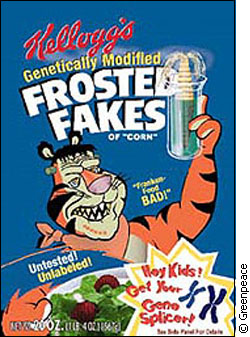| Gambling
with your food?
The GM debate
By Katy Peplinskie
OTTAWA — In
1994, a seemingly innocuous fruit – the Flavr
Savr tomato – burst on the scene. This genetically
engineered organism was designed by Calgene with an
extra gene to ensure tomatoes could ripen on the vine,
halfway around the world, yet still make it to supermarkets
before spoiling.
 |
| Genetic modification refers
to the manipulation of an organism's genetic make-up
through the introduction or elimination of specific
genes. |
But though the magic of transgenics worked
to give the fruit a longer shelf life, it was still
a bust. The public loudly voiced its dissent, refusing
to buy any sort of “Frankenfood.”
And so genetically modified crops were
thrust into the limelight.
Though “genetic modification”
simply refers to the manipulation of an organism's genetic
make-up through the introduction or elimination of specific
genes, critics dubbed modified organisms “genetically
mutilated” and “genetically mutated.”
Opponents foretold countless health risks and an environmental
apocalypse.
Greenpeace even catered to the public’s
basest fears by representing modified foods with gigantic
three-dimensional corn cobs, equipped with open, dark
red lips and aggressively displayed fangs.
But what was the reason for this frenzy?
And why does the fear-mongering over genetically modified
organisms continue, unabated, today?
As Princeton University biologist, Lee
Silver, says, “Many scientists take the Luddite
stance that genetic technology can only be harmful,
and refuse to see the obvious benefits they bring.”
Silver also makes reference to a non-scientific
camp which has been especially vocal in its opposition
to modified foods — the left-leaning, spiritually-minded
intellectuals. “As the left’s argument goes,
to play with nature is to try and play God,” Silver
says.
'Many
scientists take the Luddite stance that genetic
technology can only be harmful.' |
And though such voices used to be relatively
subdued in Canada, save for a few ecologists or granola
muncher picketing on Parliament Hill, Canadians are
becoming increasingly loud in their dissent.
Dr. Brian Ellis, co-author of the Royal
Society of Canada’s recommendations to the Canadian
government on how to regulate genetically modified products,
falls squarely into the first camp. He is a scientist
opposed to the sale of genetically modified foods.
“I’m not trying to be paranoid,
just safe,” he says. “We simply haven’t
done enough long term testing on these foods in Canada
or any place else, to make any concrete conclusions
about them. They’re simply too new.”
He says researchers must continue studying
these foods for biochemical reactions to decide if they
might be harmful to human physiology over the long term.
“Since no gene controls only one feature of any
organism, the introduction of a gene from one living
organism into another completely unrelated organism
might cause unidentified biochemical reactions in the
still-stabilizing DNA that can be harmful to people.”
Health concerns aside, Ellis argues that
tampering with the genetic makeup of plants can have
unforeseen consequences for plant life, such as the
development of “super weeds” that are resistant
to pesticides.
 |
| Many foods in grocery stores,
like Frosted Flakes, contain genetically modified
ingredients. |
Ellis says it’s also possible that
plants “emitting toxins as a result of modification
could cause natural pests to mutate into bigger, stronger,
more resistant bugs.”
A final scientific concern involves “genetic
pollution” or cross-contamination. Opponents of
genetic modification worry that pollen from genetically
modified fields could eventually find its way to fields
of unmodified crops, and even to wild plants, potentially
creating untested and unpredictable strains of plant
life.
Because of these concerns, critics of
genetically modified crops – which include such
diverse groups as Greenpeace, the Green Party, the World
Wildlife Fund, and the European Union – argue
that public policy ought to follow the precautionary
principle, better safe than sorry.
However, as scientist Richard Lewontin
writes in his essay "Genes in the Food!,"
many of their fears are unwarranted. “Transgenes
are not spread like microbes, entering the body from
the outside,” he says.
“Instead, they are transmitted by
reproduction of the entire genome of an organism, and
if a cross occurs between an engineered plant and a
wild relative, the result is an offspring that is hybrid
in every respect, including all those characteristics
that make cultivated varieties so ill-adapted to survival
in nature.”
“And so we find ourselves
in a puzzling situation,” says Dr. Mark Winston,
a researcher at Simon Fraser University. “We haven’t
had a single catastrophe to engender such sweeping public
apprehension over genetically modified organisms, and
yet so many people remain opposed to them.” Like
Silver, Winston wonders why people still haven’t
realized the mounting scientific evidence that proves
the benefits of these organisms.
According to a United Nations Development
report, many genetically modified varieties of rice,
soybean, millet and cassava have been shown to have
50 per cent higher yields. “This is important
since the more food people are able to grow on an acre
of land, the less land that must be cleared for agriculture,”
says Winston.
| 'We haven’t
had a single catastrophe to engender such sweeping
public apprehension over genetically modified organisms,
and yet so many people remain opposed to them.' |
The same UN report states that these
same modified plants mature about 30 to 50 days earlier,
are substantially richer in protein, are especially
disease and drought tolerant, and are more resistant
to insect pests than traditional plants. Engineered
varieties are also expected to help cut farmers’
costs since they can be grown without fertilizer or
herbicides – luxuries which many poor farmers
can’t afford.
The report also says that in China, where
more than four million small farmers are growing genetically
modified cotton on about 30 per cent of the country’s
total cotton area, yields for insect-resistant cotton
were about 20 per cent higher than for conventional
varieties.
Pesticide costs were also around 70 per
cent lower. In fact, pesticide use was reduced by an
estimated 78,000 tons in 2001, an amount equal to about
one-quarter of the total quantity of chemical pesticides
used in China. As a result, cotton farmers experienced
fewer pesticide poisonings than those growing conventional
varieties.
There are many other innovations that
have also been made possible through genetic engineering.
A 1999 study published in the journal Nature Biotechnology
found that 96.2 per cent of genetically modified plants
could survive freezing experiments, versus just 9.5
per cent of unaltered plants. When subjected to drought
conditions, three quarters of the modified plants survived,
compared with just two percent of the traditional plants.
“It’s easy to understand
the benefits for foods being able to withstand such
low temperatures,” says Winston. “The hardier
the plant, the less food will be lost to the elements.”
In addition to these environmental gains,
genetically modified foods have also been proven to
have enormous potential for improving human health.
One example is the creation of Golden Rice, which contains
added Vitam A as carotene, and which will eventually
be available for commercial planting. This type of rice
is produced by splicing three foreign genes –
two from the daffodil and one from a bacterium –
into japonica rice, a variety adapted for temperate
climates. Thus, genetically engineered foods may help
increase our vitamin consumption, and contribute to
improved human health.
| 'This kind
of genetic modification takes mankind into realms
that belong to God, and to God alone.' |
But though the first camp may skirt these
benefits, Silver says the second camp – the “spiritualists”
– generally accept that modified foods do provide
a multitude of benefits.
However, they call genetically engineered
food an assault on the sovereignty of God. As Prince
Charles said in an interview with The Times of London,
“This kind of genetic modification takes mankind
into realms that belong to God, and to God alone.”
One would think by listening to the dissidents,
that everything in this world other than engineered
foods was natural. Silver says: “Critics seem
to think that valleys of well tended meadows, neat farms
and grazing cows represent a natural order that must
be conserved – though every component of this
picture is the result of human intervention into a previous
natural order that disappeared long ago.”
He adds that opponents of genetic modification
seem to seek a return to an idyllic life never even
experienced by this generation.
Lewontin agrees, writing, “People
seem to yearn for the independent family farmer, tilling
the soil, in touch with nature, making decisions about
what and when to plant and harvest from his craft knowledge,
sitting down at dinner to a groaning board of home-grown
victuals prepared by his aproned wife.” He points
out, however, it is far too late in the game to realize
such a reality.
Indeed, even before genetic engineering
became popular in the nineties, agriculture was one
of the most unnatural human endeavors ever conceived,
says Silver.
In fact, mankind has been tinkering with
Mother Nature for thousands of years, encouraging certain
breeds and strains that had obvious advantages over
less promising varieties.
According to Lewontin, “the results
of many ancient modifications have been organisms that
are not only very different from their wild ancestors,
but are in many characteristics, the very opposite of
the organisms from which they were derived.”
Lewontin uses the example of the compact
ear of maize with large kernels adhering tightly to
the cob to make this point. “It is very useful
in a grain that needs to be gathered and to be stored
for long periods, but a plant with such a seed head
would soon disappear in nature because it could not
disperse its seed.”
But though Canadians are generally thought
of as being liberal and open-minded, Rod Phillips, a
professor of food history at Carleton University, says
they increasingly seem to be buying into the concerns
over genetically modified crops.
“Canadians just seem to be
hitting their stride when it comes to the genetically
modified foods debate,” he says.
Phillips says this explains the current
hearings being held in Prince Edward Island which may
lead to a province-wide ban on modified crops. He also
says the push for labeling of modified foods is getting
stronger, adding that the government may soon come around
and smack all genetically altered foods with labels.
| Mankind
has been tinkering with Mother Nature for thousands
of years, almost always encouraging certain breeds
and strains that had obvious advantages over less
promising varieties. |
But where does the impetus for these
changes stem from?
“Canadians have probably
always harboured concerns over genetic modification,
but felt they had their hands tied,” reasons Phillips.
“Canadians recognize that
much of our food supply comes from the United States
where they are doing nothing to stop the production
of modified foods. Because of our close relationship
and open border policy with them, it’s hard for
us to do much.” But, like Silver, Phillips also
says it’s ironic that so much opposition to genetically
modified foods exists. “People say they want a
return to nature. They say they want things to be wholesome
and less processed. They want less chemicals, additives
and preservatives.”
“But then they go and buy
fast food. And do they buy the salads at McDonalds?
No, the core sales are highly processed foods we know
are not good.”
“It’s a strange situation,”
says Phillips. “People say they want to make the
right choices, but this desire is questionable.”
So, why all the opposition to genetically
modified foods, then?
“There are a
lot of confused people out there,” Phillips concludes.
| A
Brief History of Transgenics
1944 - Molecular
nature of genetic material discovered
|
|